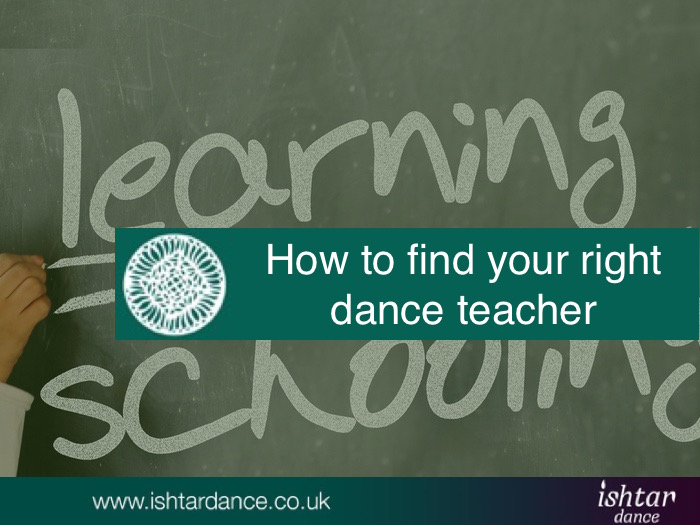How to find your right dance teacher
By Ishtar Dance on Tuesday, June, 13th, 2017 in Dance Coaching, Dance Inspiration, Learning, Your Dance Body No Comments

The belly dance world is still mourning the sad loss of Yvette Cowles, who lost her battle with cancer earlier this month. Yvette wasn’t just a fellow JWAAD tutor, she was also a dear friend, inspiration and mentor of mine. I could write endless columns about her wonderful teaching and dance style, but many people already know that, as she touched so many lives with her infectious laugh and happy approach to movement. So instead I will share some tips on how to find a dancer teacher that’s right for you.
Personality
Learning dance is a very personal journey and personality is therefore hugely important. You need to click with the person teaching you as that will ignite the fire in your belly to keep coming back, even when things might be difficult in your personal, work or even dance life. So if you’re new to dancing, you may want to make a phone call, or go along for a one-off class to see whether you like the person teaching it. You have to be able to trust the teacher, so if you aren’t comfortable around them, then don’t waste your time, and try another class instead.
Knowledge
The teacher needs to be knowledgeable and able to explain to you and everyone else how to move. If you don’t get it, then do ask lost of questions, even if others in the class don’t. People are very different in the way they learn, and any good teacher should be able to explain moves in many different ways, so everyone get’s it. Executing the move successfully is of course a totally different matter, and probably something you’ll need to practice lots!
If you’re new to dancing it may take some time before you discover whether your teacher is knowledgeable or not. You can of course ask some of the other students, but they may not be the best to answer. You can also do some research to find out if they’re part of any professional dance or teaching organization, such as The JTA, JWAAD, Dance UK, or similar by checking their website or the website of the organization.
You can also use social media to see what their dancing is like and how they may contribute to any professional dance discussions. Check out their YouTube and Facebook accounts, but do be aware that someone’s online profile can be somewhat different to what they present in a class situation. It’s also important to note that a great dancer not necessary makes a great teacher, and visa versa. The two are linked but I have seen many great performers who can’t teach what they do to others, and similar the other way around
Learning from others
Even if you love your teacher, it’s always a go idea to try out others too, ideally someone with a different dance style, who can teach you what your regular teacher can’t. You will have to bare in mind that their teaching style and even the way the describe moves and their names may be different, but that shouldn’t be a barrier. Once you know your basics, and feel ready to try something new, then go for it. You will soon realize what the other teacher means when they call it an XYZ.
I always encourage my students to learn from other, and when they attend festivals where I teach, I always tell them not to come to my workshops, but to try others. I am always happy to recommend other teachers too. I know I can’t teach them a mind blowing hip hop belly dance fusion, but am more than happy to tell them who can.
Workshops and festivals
One of the best ways to grow in confidence as a dancer and push yourself both technically and creatively is to attend dance festivals and holidays. It’s just so subversive and will really challenge and develop you. Ten years ago it was very hard to find good festivals, but nowadays it’s very easy. My personal national favorites are the JWAAD Summer School in Berkshire (August), Jewel of Yorkshire (October), Fantasia Festival in London (December), and Borwich Hall in Lancashire (May). These have all got well respected and knowledgeable international as well as national teachers, and run several workshops alongside each other so there’s always something of interest no matter what level you’re at.
Once you’ve attended a few of these you’ll probably be ready to start going to international workshops, which often will take you to some amazing destinations as well, and therefore perfect to combine with a few days ‘traditional holiday’. But do make sure you know your basics first and have done your research. International festivals can soon become overwhelming, especially if they’re not that well organized or the teachers can’t translate what it is they are trying to teach you.
Moving on
You may love your teacher but at some point it might be time to move on. Either because you need another challenge, or because you’ve outgrown your current teacher. There is nothing wrong with this, although I know it can be tough to realize for both parties. But it’s a bit like moving house – it can be very daunting, but once you do it, and are forced to reassess all that you have (learned) and how to make it work in a different context, it can really develop and grow you as a dancer.
So when do you know it’s time to move on? When you no longer feel inspired going to class. You may technically be better than your teacher, you may even be semi-professional, but a good teacher should always be able to inspire and push you to become even better. Some of the best dancers teach way into a ripe old age, where they no longer may be able to perform all the moves that they teach, but they will still be able to grow their students and not least inspire them.
When do you no longer need a teacher?
Well to be honest I don’t know when this is, because as a dancer you will always need someone to develop you. Once you reach a semi-professional level, regular teachers may be replaced with mentors, who help you work on more specific elements of your dancing, and international workshops to help feed your inspiration. This is the beauty of dance – there is always something to learn. But you may also change your dancing depending on where you are both physically and creatively. At a young age tricks are often all the rage, and then you may all of a sudden realize that you prefer melting into taksims and improvisational techniques more. Different styles may also take your fancy whether it’s Lebanese Dabke, Khalegy or others.
I will soon be re-launching my Personal Development Programme for dancers of intermediate to a professional level. If you want to be the first to know all the details then you sign up to my emails here.
How did you find your teacher? Have you got any tips for others on any elements covered in this post? Please let me know keep the conversation and knowledge sharing going by adding your comments below.
Happy dancing always…
Dorte
Did you miss my last post? Read it here: How to be a pro: Belly dance performer

Leave a Reply